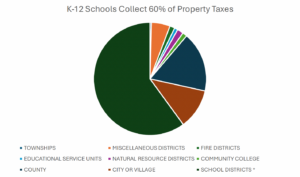Nebraska Tops Charts for K-12 Property Tax Reliance
Nebraska policymakers have been focused on property tax relief for 5 years, and for good reason. According to Tax Foundation’s most recent analysis, Nebraska’s property taxes are the eighth-highest in the country and higher than any neighboring state.
Tax Foundation calculated Nebraska’s average effective property tax rate to be 1.44% in 2022. This rate is lower than in preceding years due to the property valuation spike that occurred in 2021 and 2022. Whereas Nebraska’s effective rate was 1.63% in 2021, it fell to 1.44% in 2022 not because of local tax-cutting but rather because of a nationwide surge in property valuations and federal aid to local governments. A similar effect was seen across other states, with New Jersey dropping from 2.23% to 2.08%, Texas dropping from 1.68% to 1.47%, and Vermont dropping from 1.83% to 1.56%.
In Nebraska as in most states, the major driver of the total property tax burden is the K-12 school district property tax. K-12 schools collect almost exactly 60% of all Nebraska property taxes. In 2024, school districts accounted for $3.2 billion in property taxes out of a $5.3 billion total property tax burden.

In comparison to other states, Nebraska was 3rd most reliant upon property taxes in Fiscal Year 2021 for K-12 school funding. Local Funding (i.e. property taxes) made up 65.7% of Nebraska’s combined state plus local funding of K-12 according to the data from the National Center for Education Statistics. In the same year, school district property taxes were $2.8 billion. Although this data is from Fiscal Year 2021, such data does not adjust quickly. Nebraska is undoubtedly in the same neighborhood of states most reliant on local property taxes for K-12 funding.
| State | Local Funding per student | State Funding per student | Local % of K-12 |
| NH | $ 13,360 | $ 6,650 | 66.8% |
| MO | $ 8,573 | $ 4,432 | 65.9% |
| NE | $ 9,398 | $ 4,917 | 65.7% |
| NV | $ 6,676 | $ 3,984 | 62.6% |
| CT | $ 14,296 | $ 8,809 | 61.9% |
| NY | $ 17,568 | $ 11,428 | 60.6% |
| SD | $ 6,682 | $ 4,400 | 60.3% |
| PA | $ 11,066 | $ 7,660 | 59.1% |
| MA | $ 12,382 | $ 9,036 | 57.8% |
| CO | $ 7,673 | $ 5,677 | 57.5% |
| IL | $ 11,423 | $ 8,567 | 57.1% |
| TX | $ 6,767 | $ 5,129 | 56.9% |
| OH | $ 8,479 | $ 6,675 | 56.0% |
| VA | $ 7,729 | $ 6,261 | 55.2% |
| FL | $ 6,047 | $ 5,041 | 54.5% |
| ME | $ 9,751 | $ 8,184 | 54.4% |
| MD | $ 9,858 | $ 8,635 | 53.3% |
| LA | $ 6,666 | $ 5,884 | 53.1% |
| RI | $ 9,877 | $ 8,934 | 52.5% |
| NJ | $ 12,770 | $ 11,809 | 52.0% |
| GA | $ 6,546 | $ 6,188 | 51.4% |
| MT | $ 6,285 | $ 6,221 | 50.3% |
| US | $ 7,419 | $ 7,799 | 48.8% |
| TN | $ 4,978 | $ 5,482 | 47.6% |
| OK | $ 4,585 | $ 5,213 | 46.8% |
| SC | $ 6,318 | $ 7,873 | 44.5% |
| AR | $ 4,714 | $ 6,261 | 43.0% |
| IA | $ 5,905 | $ 7,936 | 42.7% |
| MS | $ 4,175 | $ 5,634 | 42.6% |
| WY | $ 7,775 | $ 10,522 | 42.5% |
| AZ | $ 4,149 | $ 5,640 | 42.4% |
| OR | $ 6,647 | $ 9,478 | 41.2% |
| WV | $ 5,326 | $ 8,046 | 39.8% |
| KY | $ 4,739 | $ 7,215 | 39.6% |
| UT | $ 3,820 | $ 5,939 | 39.1% |
| ND | $ 5,927 | $ 9,385 | 38.7% |
| CA | $ 6,094 | $ 10,008 | 37.8% |
| AL | $ 3,998 | $ 7,062 | 36.1% |
| MI | $ 4,992 | $ 9,412 | 34.7% |
| WI | $ 4,992 | $ 9,412 | 34.7% |
| IN | $ 4,347 | $ 8,454 | 34.0% |
| DE | $ 5,906 | $ 12,652 | 31.8% |
| MN | $ 4,744 | $ 11,276 | 29.6% |
| NC | $ 2,895 | $ 7,027 | 29.2% |
| KS | $ 3,829 | $ 10,213 | 27.3% |
| ID | $ 2,327 | $ 6,578 | 26.1% |
| WA | $ 4,531 | $ 12,838 | 26.1% |
| AK | $ 4,341 | $ 12,588 | 25.6% |
| NM | $ 2,518 | $ 10,593 | 19.2% |
| VT | $ 486 | $ 21,115 | 2.2% |
| HI | $ 108 | $ 16,163 | 0.7% |
When federal funding is factored in, Nebraska jumps to 2nd most reliant on property taxes. However, 2021 was a highly unusual year for federal support for education given the wave of federal aid sent in the wake of the coronavirus pandemic. Therefore, the chart above looks only at state and local resources which make up the lion’s share (90%) of K-12 funding.
Nonetheless, these ratios may have moved in the four years since they were compiled. Nebraska policymakers have provided property tax credits to offset school property taxes, and they have also provided more direct aid to schools through Governor Pillen’s Education Future Fund.
Updated numbers will help Nebraska policymakers understand exactly where they stand among states. In the meantime, it is safe to assume Nebraska property taxes still provide a disproportionate share of Nebraska K-12 school funding.
